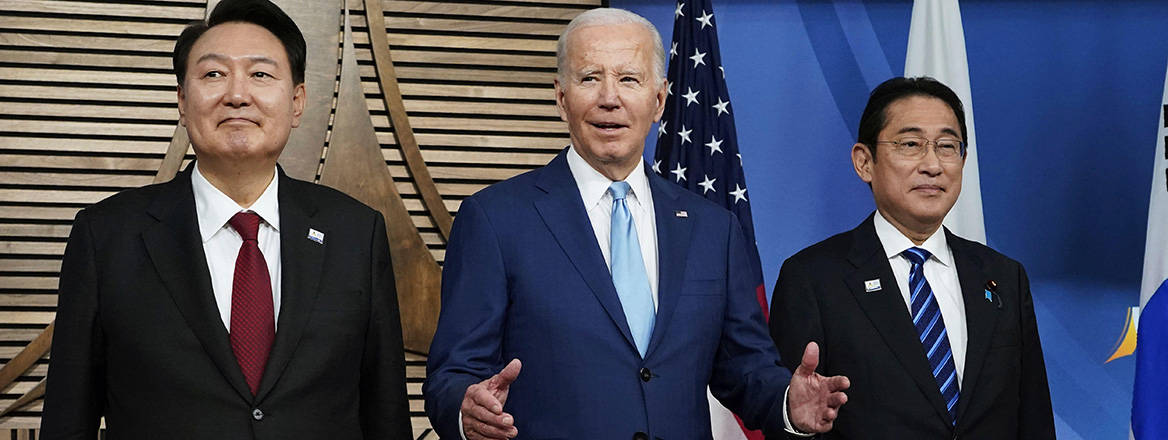RUSI
|
|
Expanding AUKUS Pillar 2: An Inclusive Indo-Pacific Alliance Structure
As discussions loom on expanding AUKUS’s Pillar 2 to include additional close US allies in the region, strong leadership and a clear vision are critical for building a more cohesive and resilient alliance structure in the Indo-Pacific.

AUKUS announced in April 2024 that consultations to engage with additional partners for Pillar 2 will begin this year. Although AUKUS initially started as a technological partnership, its potential to affect the future US alliance structure in the Indo-Pacific makes Pillar 2 expansion more of a geopolitical than a technological or technical issue. While it is true that such an expansion may further complicate some unresolved technological or bureaucratic problems, the geopolitical impact of Pillar 2 expansion needs to be more fully reflected in the discussions to ensure that the Pillar 2 partnership serves the unity of allies and partners, which is essential for maintaining a free and rules-based Indo-Pacific.
Pillar 2 Expansion: Potentially Divisive
It is unlikely that AUKUS Pillar 1 will cause any significant divergence among US allies and partners at this point. The complexities and almost unsurmountable restraints posed by regional and international non-proliferation regimes and export control regimes, as well as the huge financial commitment Pillar 1 necessitates, mean that other countries are very unlikely to show a genuine interest in Pillar 1 – not to mention AUKUS members’ clear position that the alliance will ‘always’ remain a trilateral endeavour.
Managing different expectations regarding Pillar 2 expansion can be tricky and divisive. Although cooperation involving sensitive technologies still requires the highest level of trust and information security, as well as navigating legislative and bureaucratic issues, Pillar 2 may be perceived as having lower hurdles and greater incentives for several reasons.
Prolonged speculation over who will be included in Pillar 2 also risks creating divergence among allies
First, the second Pillar does not involve the non-proliferation, which is the thorniest normative barrier for many critics. This opens a space for US partners, particularly countries such as New Zealand – a self-declared-nuclear-free country – to consider the potential benefits of joining Pillar 2. Second, Pillar 2 covers a wide array of capabilities where close US allies may possess distinct comparative advantages. A country may not excel in all the eight areas of Pillar 2, but it can still assess its unique contributions and consider how to leverage these strengths for the purposes of cooperation. For instance, Japan has advanced manufacturing and defence capabilities, and South Korea excels in its defence industry, production capability and hypersonic technologies. The nascent nature of Pillar 2 technologies is also important in the sense that Pillar 2 will be an evolving process over the coming decades rather than a one-off transaction. This gives US allies greater incentives to join Pillar 2 while fearing exclusion, particularly given the wide scope of technologies it entails and their significance for future national security.
What this means is that for close US allies in the region, failing to join Pillar 2 could be detrimental, although Japan’s participation has been repeatedly mentioned on various occasions. For instance, South Korea has openly expressed its wish to join Pillar 2, hoping for a more comprehensive and stronger South Korea--US alliance, particularly in the face of the increasing threats posed by North Korea's nuclear and missile capabilities. New Zealand is a Five Eyes member, connected to others through ANZUS, and has an interest in Pillar 2 participation. For Canada – the closest neighbour of the US, a member of the Five Eyes and NORAD and one of the closest allies of AUKUS members – exclusion from Pillar 1 has already raised questions about the strength of its relationship with the AUKUS countries.
Risk Management for Pillar 2 Expansion
The discussions for Pillar 2 expansion require a geopolitical sensitivity that transcends bureaucratic hurdles. Creating immaculate modalities for cooperation is a sensible but impractical idea, as there will always be some problems remaining, and more time does not guarantee that they will be resolved them. Prolonged speculation over who will be included in Pillar 2 also risks creating divergence among allies, as it could separate alliance tiers and cause concerns over exclusion and even abandonment – giving adversaries an opportunity for manipulation. AUKUS needs to pass through this membership speculation stage swiftly and without too much noise in order to minimise such risks.
For this purpose, it is crucial that four countries—Japan, South Korea, Canada and New Zealand—are all invited to join Pillar 2, not necessarily in all eight areas, but in realms where they can contribute. These close US partners are also effectively aligning their positions as a group with NATO through the AP4 format, which enables the use of this developing channel for communication, furthering cooperation and enhancing interoperability.
While Japan’s participation is becoming more of a reality, the other three countries have different but legitimate reasons to be concerned about exclusion. Accordingly, Pillar 2 membership for these countries is likely to be regarded as a litmus test for their status within the US alliance system in the region. Excluding any of these countries from Pillar 2 would risk stigmatising them as second-tier partners in the alliance system and further expose them to Chinese pressure, which will target the weakest link wherever it may be.
It would also empower domestic opposition to close alignment with the US in the excluded countries, making amendments to or enactment of relevant laws and regulations to strengthen information security and arms export control measures – which will be necessitated by Pillar 2 participation – even more difficult due to domestic division and opposition. All of these international and domestic repercussions of potential exclusion would make Pillar 2 participation for these countries more difficult in the future, ultimately weakening the aggregate capacity of the US alliance.
AUKUS – whether intentionally or not – now carries greater geopolitical implications beyond its initial objective of providing nuclear-powered submarines to Australia
Announcing such participation simultaneously as a whole, where possible – rather than one by one – could be an effective strategy. If the participation of one country is officially confirmed first while that of the others remains undecided, this would expose the remaining countries to strong pressure from China with the aim of preventing further participation. South Korea and New Zealand are particularly vulnerable to such attempts given their high economic dependence on China and, in the case of South Korea, due to domestic division over foreign policy.
Conclusion
Any alliance, be it a defence treaty or technological partnership, intrinsically has an exclusive nature, creating a division between ‘us’ and ‘them’. However, AUKUS – whether intentionally or not – now carries greater geopolitical implications beyond its initial objective of providing nuclear-powered submarines to Australia. This means that AUKUS Pillar 2 expansion needs to embrace key US allies and partners as ‘us’, considering the overall future US alliance structure in the region while developing modalities for Pillar 2 cooperation along the way.
It does not mean, however, that potential partners can remain complacent and simply wait to be invited. Efforts to strengthen information security and existing but insufficient anti-espionage regulations, for instance, can begin even before any invitations are formalised. Either way, this is a time when political leadership at the highest level and a common vision for a free and open Indo-Pacific are imperative in order to overcome bureaucratic hurdles and move forward.
The views expressed in this Commentary are the author’s, and do not represent those of RUSI or any other institution.
Have an idea for a Commentary you’d like to write for us? Send a short pitch to commentaries@rusi.org and we’ll get back to you if it fits into our research interests. Full guidelines for contributors can be found here.
Original article link: https://rusi.org/explore-our-research/publications/commentary/expanding-aukus-pillar-2-inclusive-indo-pacific-alliance-structure


